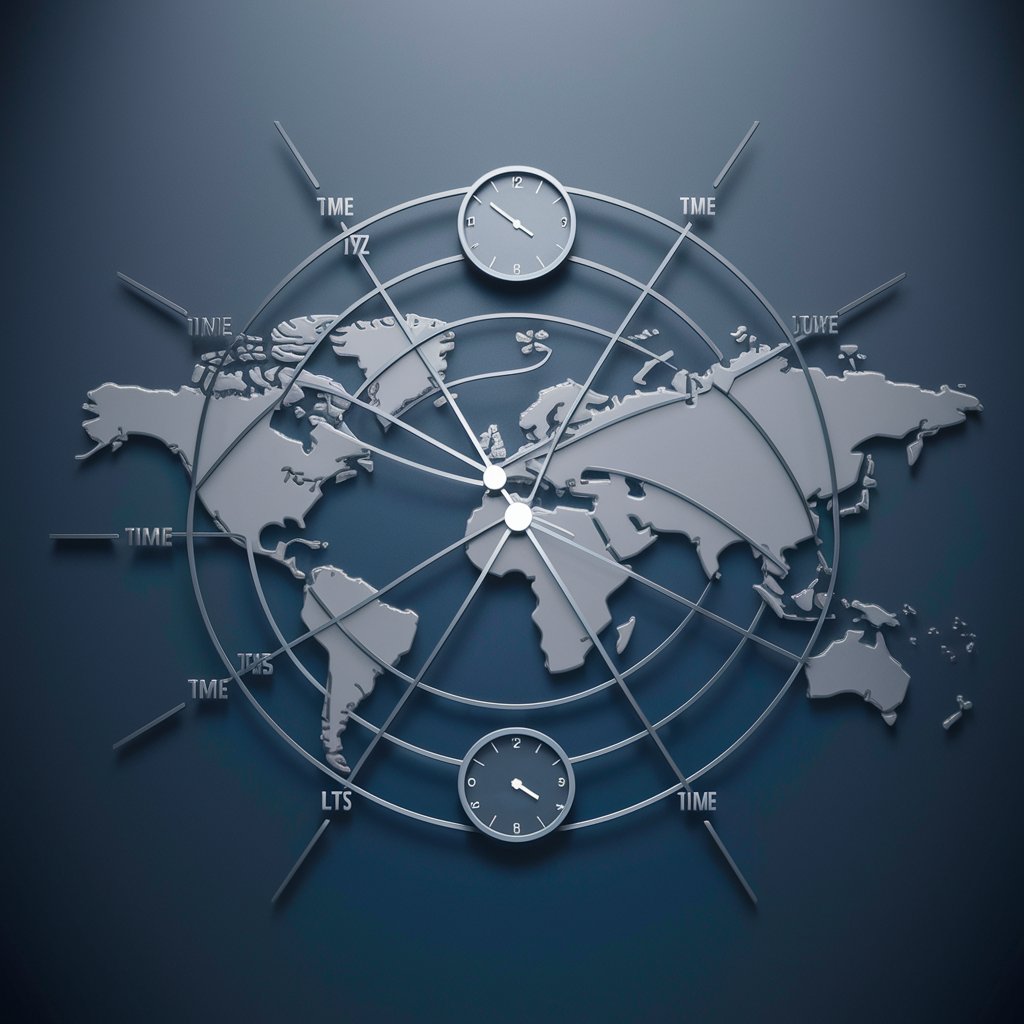Time zone - Global Time Zone Converter

Welcome! Let's explore the world of time zones together.
Navigate time zones effortlessly with AI
Explain how time zones were developed and their historical significance.
Describe the impact of time zones on international business and communication.
How do daylight saving changes affect global timekeeping and scheduling?
What are some examples of challenges people face due to different time zones?
Get Embed Code
Understanding Time Zone GPT
Time Zone GPT is designed to serve as an educational tool focused on the concept of time zones and their significance in global timekeeping. It explains the mechanisms of how time zones work, the history behind their development, and their impact on various aspects of modern life including business, communication, and travel. By providing detailed explanations, historical context, and current applications, Time Zone GPT aims to enhance understanding and facilitate navigation of global timekeeping challenges. For example, it can elucidate the rationale behind the existence of multiple time zones across the world and how they aid in synchronizing time in accordance with the Earth's rotation and the position of the sun. Powered by ChatGPT-4o。

Core Functions of Time Zone GPT
Educational Insights
Example
Explaining the history and rationale behind the creation of the International Date Line.
Scenario
A student preparing for a geography quiz needs to understand the concept of the International Date Line and its implications for timekeeping.
Time Conversion
Example
Converting 3:00 PM GMT to Eastern Standard Time (EST).
Scenario
A business professional scheduling a conference call with colleagues across different continents needs to find a suitable time for all participants.
Daylight Saving Updates
Example
Providing the dates and times daylight saving time starts and ends in various regions.
Scenario
A traveler planning a trip across countries wants to know if daylight saving time will affect their travel schedule.
Global Time Inquiry
Example
Checking the current time in Tokyo, Japan.
Scenario
A family in the United States planning to video call relatives in Tokyo wants to ensure they call at an appropriate time.
Ideal Users of Time Zone Services
Students and Educators
Individuals engaged in learning or teaching geography, history, or global cultures can leverage Time Zone GPT to understand and explain the complexities of global timekeeping.
Business Professionals
Professionals who coordinate with teams, clients, or partners across different time zones can use Time Zone GPT to schedule meetings, manage deadlines, and ensure smooth communication.
Travelers
Travelers planning trips across multiple time zones can use Time Zone GPT to adjust their itineraries, ensuring they account for time differences and daylight saving changes.

How to Use Time Zone
Start with a Free Trial
Begin by visiting yeschat.ai to access a free trial of the Time Zone tool without the need for login or subscribing to ChatGPT Plus.
Identify Your Time Zone Needs
Determine the specific time zone information you need, whether it's for scheduling international meetings, understanding global time differences, or planning travel across time zones.
Utilize Time Zone Conversion Features
Use the Time Zone tool to convert time between different time zones, ensuring accurate scheduling and communication across geographical locations.
Explore Daylight Saving Changes
Stay informed about daylight saving changes in different time zones to adjust your schedules accordingly and avoid any confusion.
Leverage for Planning and Scheduling
Apply the knowledge gained from the Time Zone tool for efficient planning and scheduling of international calls, meetings, and travel.
Try other advanced and practical GPTs
Lofi Visual Harmony
Craft Your Vision with AI-Powered LOFI Imagery

Janitor
Your AI partner in pristine environments

ChristieBot
Your AI-powered appliance guide

Irina Vladimirovna
Enhance Your English with AI

Otaku
Discover Your Next Favorite Anime

Expert en Composants Dynamiques SketchUp
Elevate Your SketchUp Projects with AI-Powered Dynamic Components

Math Quiz
Elevate Your Math Skills with AI

Halal Forex Guide
Empowering Halal Forex Trading with AI

Podcast Finder
AI-driven podcast discovery and listening.

课程大纲编写
AI-powered course planning tool

Brand Blogger Pro
Elevate Your Brand with AI-Powered Blogging

Dark Romantic Adventure
Shape your dark romance adventure.

Time Zone FAQs
What is a time zone?
A time zone is a region of the globe that observes a uniform standard time for legal, commercial, and social purposes. Time zones tend to follow the boundaries of countries and their subdivisions instead of strictly following longitude, because of the practicalities of commerce and communication.
How are time zones determined?
Time zones are determined by dividing the Earth into 24 sections, each representing a time zone. The time in each zone is based on the mean solar time at a central meridian for that zone, typically in 15-degree increments of longitude from the Prime Meridian in Greenwich, England.
What is UTC and how does it relate to time zones?
UTC (Coordinated Universal Time) serves as the primary time standard by which the world regulates clocks and time. Time zones are defined as offsets from UTC, with UTC itself being zero hours offset (UTC+0).
How do daylight saving changes affect time zones?
Daylight saving time (DST) is the practice of setting the clock forward by one hour during the warmer months to extend evening daylight. This affects time zones where it's observed, shifting the standard time temporarily by +1 hour.
Can Time Zone help with scheduling across different countries?
Yes, the Time Zone tool is designed to assist with scheduling across different countries by providing accurate time conversions and taking into account daylight saving changes, ensuring that communication and planning are seamless across time zones.
